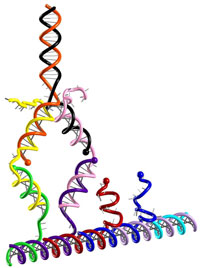ARLINGTON, Va., Aug. 12 -- The National Science Foundation (NSF) announced that it will fund a new group of chemical bonding centers (CBCs), or multifaceted research teams. The three new centers will be based at the California Institute of Technology, Columbia University and the University of California, Irvine (UCI). Respectively, they hope to find new and more economical ways of storing solar energy, to illuminate the inner workings of molecules and to create new kinds of nanoscale molecular machines for drug delivery and other applications.
CBC awards are funded through NSF's division of chemistry. Each award provides $1.5 million to the center over a three-year period. At the end of that time, those centers showing high potential will be eligible to continue their work with a Phase II award, which will provide $2 million to $3 million per year for up to five years. These awards are also potentially renewable for an additional five years.

The type of DNA-based walker to be explored at the new CBC for molecular cybenetics. All the various DNA strands involved in its operation are synthesized artificially. Rising in a vertical double helix are the orange and black strands that form the body and legs of the walker itself. Along the bottom is the multicolored spiral of a DNA-based "track," which also carries a series of green, purple, red and blue "attachment" strands. The motion of the walker is powered by two types of free-floating "fuel" strands, colored yellow and pink, which alternately come in, intertwine with the appropriate leg and attachment strand, and then detach to allow the walker to take the next stride.(Illustration: Niles A. Pierce, California Institute of Technology)
Caltech chemist Harry B. Gray and his colleagues from Caltech and the Massachusetts Institute of Technology will pursue efficient, economical ways to store solar energy in the form of chemical bonds--an advance that is critical for using sunlight as a renewable source of fuel and chemical feedstocks -- at their new chemical bonding center. The researchers will focus on getting sunlight to split water into its higher energy building blocks, hydrogen and oxygen. They will also work to raise public awareness about the importance of renewable energy and the scientific challenges required to address it.
The new CBC for molecular cybernetics, headed by Columbia's Milan N. Stojanovic, will have eight principal investigators from seven institutions: Columbia, Boston University, Caltech, the universities of Michigan, Chicago and New Mexico and the Hospital for Special Surgery in New York City. The center's goal will be to produce synthetic molecular machines powered by chemical bond transformation. To achieve this, the researchers will synthesize chemical structures having two or more protruding appendages of DNA, each able to grab onto or let go of a surface in response to an external stimulus. This should allow the structure to move across the surface like a molecular "spider." If successful, the construction of such autonomously moving molecules would generate considerable scientific and public interest, and could lead to applications in areas such as drug delivery and nanopatterning.
The goal of UCI chemist Shaul Mukamel at his CBC is to get a better understanding of the inner workings of molecules. Mukamel will head a team of researchers from Irvine and the University of California, Santa Barbara. Using both theory and experiment, they will probe the real-time inner workings of molecules at single-atom resolution, with the goal of illuminating elementary chemical events such as the gain and loss of an electron from a single molecule, the making and breaking of chemical bonds and the transport of charge among molecules. Ultimately, these investigations should lead to real-space, real-time pictures of chemical processes at the most fundamental level -- in effect, time-lapse sequences of chemical events as they occur.
For more information, visit: www.nsf.gov